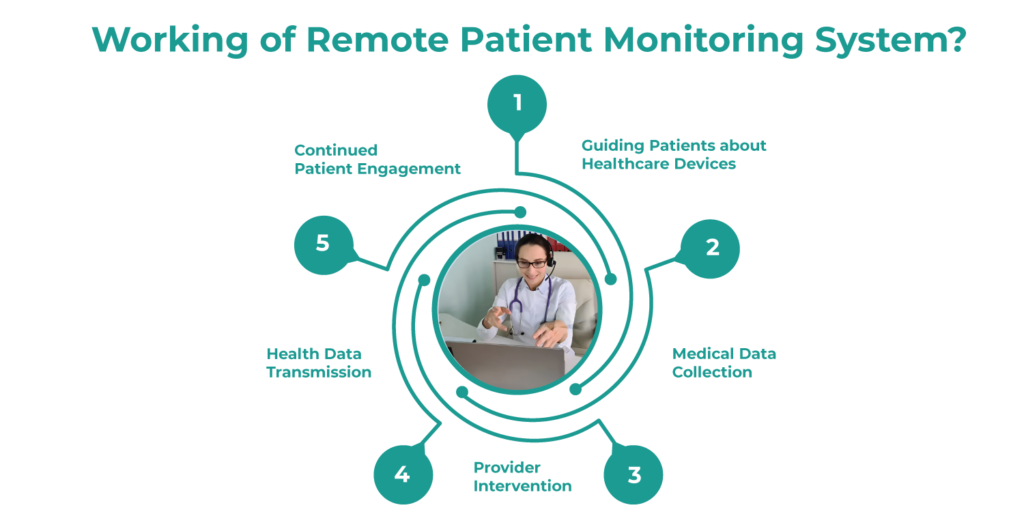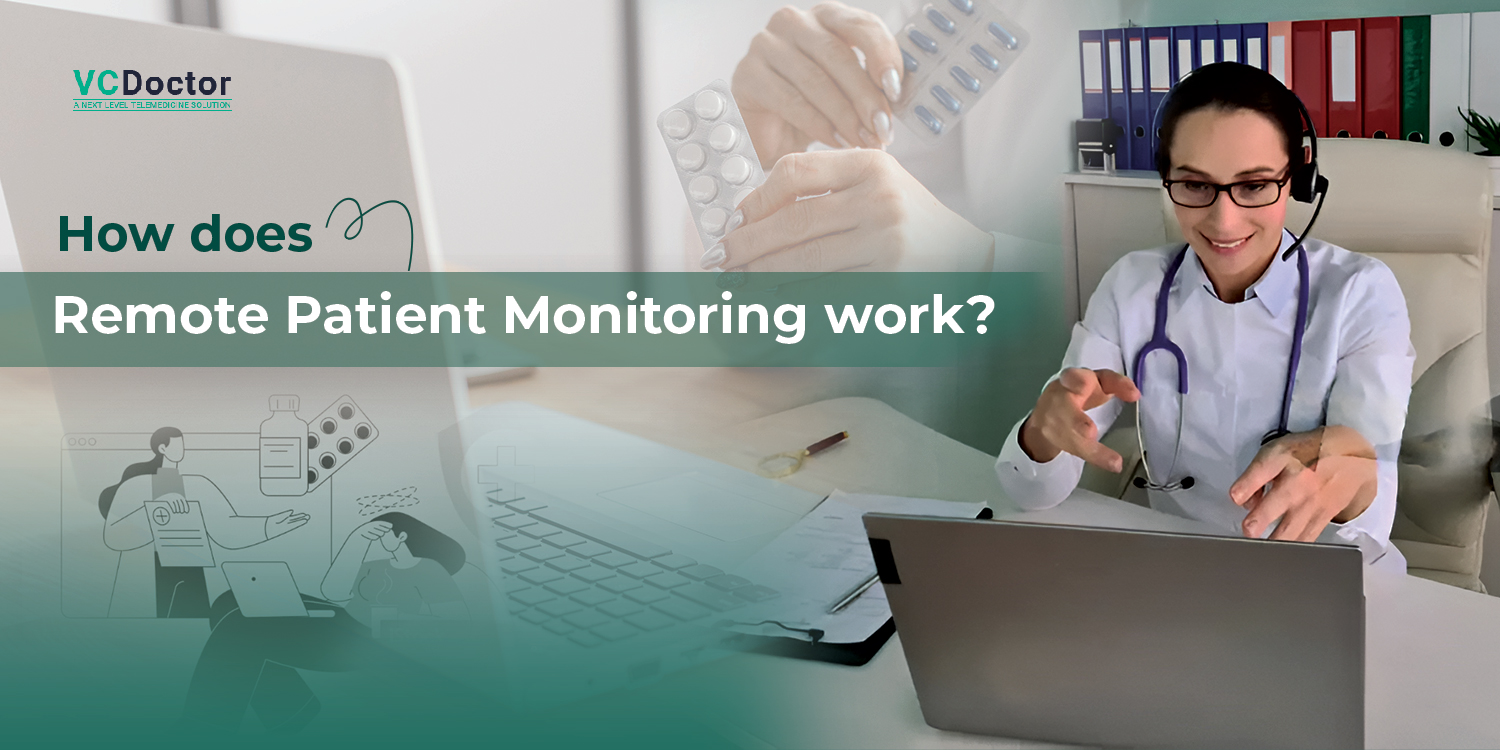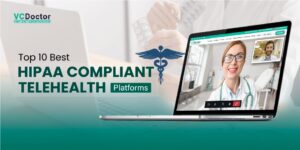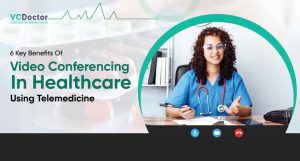How does Remote Patient Monitoring work?
Remote patient monitoring is a collection of technology and procedures that allow healthcare providers to track improvements in the health data of a patient from a distance in real-time and use it in a treatment plan. RPMS’s an important part of the larger e-health and telehealth platform. Below we are discussing How does Remote Patient Monitoring work?
Remote patient monitoring utilizes emerging technology in one place to gather medical and other types of health data from users and this information is safely distributed remotely to health care providers in various areas for review and recommendation.
When patients and health care providers want health to be tracked outside of the healthcare setting, Remote patient monitoring is becoming more common.
Remote monitoring focuses on medically ill patients, post-operative patients and remote patients with restricted access to healthcare services.
Working of Remote Patient Monitoring System?
Remote patient monitoring technology provides healthcare practitioners with real-time information about their patients’ health. doctors can provide a suitable Gadget to the patient through which they can track their health status and register it on the domain. After that this data will be safely transferred to a hospital information system that enables remote patient monitoring.

1. Guiding Patients about Healthcare Devices
Doctors can provide information about the various healthcare devices that patients can use at home to diagnose issues. Additionally, some patients might be unaware of the uses of different health devices with the guidance of professionals who can easily understand how to monitor their health status and provide accurate feedback to the doctors.
2. Medical Data Collection
Remote Patient monitoring systems help Doctors and patients secure their data at a drive or safe place where they can easily keep track of their previous healthcare status and medication. It helps to streamline the process of securing medical data so that all the patient’s medical history is stored in a single place.
3. Provider Intervention
Remote patient monitoring generates a continuous flow of health data. It actually depends on the healthcare provider to analyze and provide responses with actual data to patients. Providers assess the data and spot trends or red flags. After that, they implement timely interventions such as prescription modifications or remote consultations, resulting in better patient outcomes.
4. Health Data Transmission
With the help of a remote patient monitoring system, patients can easily select the required data collected from the medical electronic devices and transfer it to the expert. RPM enables the user to securely transfer data and keep track of records so that the doctor can customize the medication as per the current status of the patient.
5. Continued Patient Engagement
RPM is the best platform for communicating with doctors. When a patient saves lots of time and investment and can customize their needs and choose the best doctor as per their need. When any patient takes healthcare facilities at their home, it becomes convenient for them to make use of remote patient monitoring services frequently.
Benefits of Remote Patient Monitoring
1. Improved Quality
Remote monitoring also has the potential to increase the standard of treatment, in addition to improving the volume of care. Since remote patient monitoring links physicians with appropriate medical data more directly (and almost instantly), it makes their everyday routines more productive and eases the risk of burnout, resulting in visible benefits for online patient care.
Much further, by developing a framework in which individuals are more involved with and responsible for their well-being, remote monitoring promotes patient behavior. Efficient remote patient monitoring programs deliver equipment that is genuinely relaxed and common for patients, far from being the icy, sterile, daunting medical technology that comes to mind for many customers.
2. Remote Patient Monitoring Eliminates Unnecessary Visits
Remote monitoring moves in by tracking patients around the clock and submitting reports in real-time to health care providers when it comes to reducing healthcare costs. The demand for in-person visits is changing as a consequence.
In-home healthcare treatment services capture critical health statistics using remote monitoring, such as readings of blood pressure, pulse rate, respiration, glucose levels, weight, and more. It reduces the need for daily, in-person appointments that are all about obtaining health information.
3. Improve care experience with Remote Patient Monitoring
Remote patient monitoring increases the experience of treatment by supplying people with everyday contact, thereby enhancing the quality of life and keeping patients at home. Remote monitoring affects the second objective of healthcare, patient retention, allowing them the ability to connect on a daily basis. As patients are detected, it really leads to improved outcomes and pushes them onto a self-management basis, improving their condition.
4. Makes Accessible and Affordable Healthcare
Remote monitoring alerts patients and clinicians about wellbeing parameter fluctuations, which helps them to handle the problem before things get out of control. Advanced characteristics that monitor pulse rhythm, ECG, respiratory rates, blood pressure, blood oxygen volume, etc. will help avoid accidents such as extreme hypoglycemia, blood clots, and heart blocks. It also makes it easier for people to keep track of their well-being without daily checkups, saving time and money because they do not have to be physically present in hospitals.
5. Improved Patient Outcomes
Remote monitoring possibilities include catching out-of-range beliefs that may be dangerous, identifying patterns that could suggest a need to adjust the treatment regime, and getting coaching on everyday decisions that may sometimes be put aside considering their substantial effect on chronic illnesses, such as physical exercise. In conjunction with health-promoting help, such as coaching on sleep or stress control, such benefits may improve.
6. Reduced readmissions Remote Patient Monitoring
Remote monitoring helps enhance patient interaction and attitudes by leveraging consumer-centric devices (smartphones, laptops, software, etc.), and making patients more responsible for their own care. Unlike the largely impersonal medical technologies they are usually introduced to in healthcare environments, successful corporate success improvement systems strive to use technology that is intuitive and convenient for patients.
For improved disease-management assistance, Remote monitoring provides patients with higher levels of reviews, connectivity, and knowledge. That leads to better health outcomes, lower readmission rates, and increased health of the population.
7. Early symptom detection
Healthcare facilities consistently receive real-time patient health data with a remote patient monitoring solution. The solution measures clinical parameters and offers important information on the course of the illness or injury. This data will help you change the treatment plan, prevent potential epiphenomena, and avoid chronic care management emergencies.
Conclusion
Remote patient monitoring services eliminate the gap between in-person visits of patients with doctors. Now it has become easier to collect health data through software on a daily basis. It promotes proactive care by allowing for quicker interventions, changes to treatment regimens, and better patient results. RPM broadens the scope of treatment outside the doctor’s office, enabling better management of chronic illnesses and maybe early diagnosis of health risks.
FAQs
1. What kind of devices are used in RPM?
RPM uses a variety of medical gadgets to provide convenience to the patient in tracking their health status. Blood pressure cuffs, weight scales, pulse oximeters, glucometers, and spirometers are some of the most common examples.
2. How often is my data transmitted in remote patient monitoring devices?
The frequency of data transfer varies according to the health condition being monitored and the doctor’s orders. It might vary from real-time continuous monitoring for severe situations to daily or weekly transmissions for chronic illness management.
3. Is RPM secure? What happens to my health data?
Security is the main priority. Reputable RPM systems follow severe rules such as HIPAA to guarantee your data is secured and secure. Your healthcare practitioner is often the primary recipient of your data, allowing them to track your health patterns.
4. What are the benefits of RPM for patients?
RPM enables you to take an active role in your health management. It enables early diagnosis of possible health issues and provides improved medication for better treatment. Additionally, Dr can also track real-time data and health status of the patient through a remote Patient monitoring system.
5. Who can benefit from RPM?
RPM is effective for people who are suffering from chronic illnesses such as diabetes, heart disease, COPD, and asthma. It can also be useful for tracking high-risk pregnancies or post-operative healing.





Remote Patient Monitoring is an essential thing that healthcare should adapt quickly. It can help doctors to provide better treatment and cures to patients.